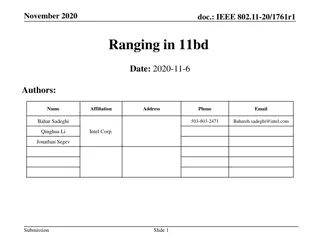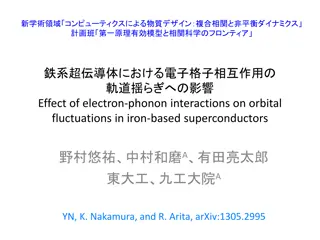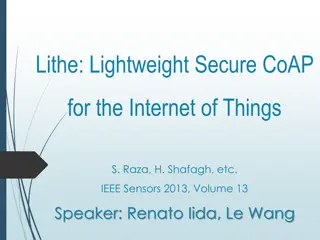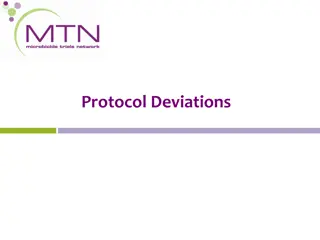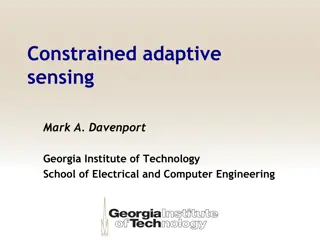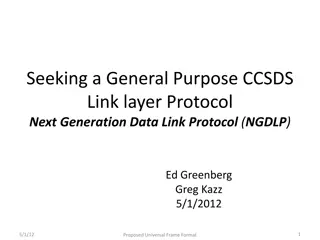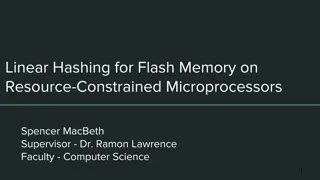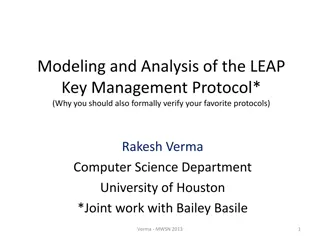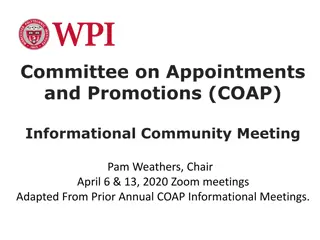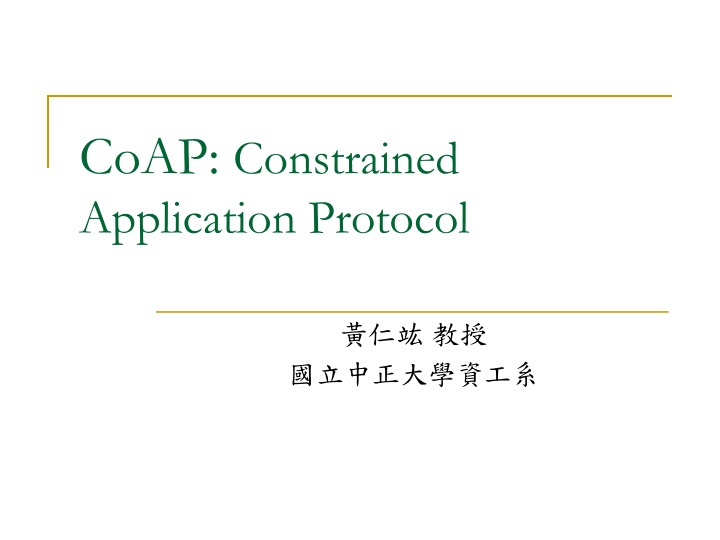
CoAP - Constrained Application Protocol Overview
CoAP, or the Constrained Application Protocol, is a specialized protocol defined by IETF CoRE WG for managing resources on devices in constrained IP networks. CoAP is RESTful, supports both synchronous and asynchronous communication, and is tailored for M2M applications. It is easy to proxy to/from HTTP but is not a replacement for HTTP. CoAP operates separately from the web and is designed for constrained devices with limited resources and intermittent connectivity.
Download Presentation

Please find below an Image/Link to download the presentation.
The content on the website is provided AS IS for your information and personal use only. It may not be sold, licensed, or shared on other websites without obtaining consent from the author. If you encounter any issues during the download, it is possible that the publisher has removed the file from their server.
You are allowed to download the files provided on this website for personal or commercial use, subject to the condition that they are used lawfully. All files are the property of their respective owners.
The content on the website is provided AS IS for your information and personal use only. It may not be sold, licensed, or shared on other websites without obtaining consent from the author.
E N D
Presentation Transcript
CoAP: Constrained Application Protocol
CoAP The Constrained Application Protocol (CoAP) is defined by IETF CoRE WG for the manipulation of resources on a device that is on the constrained IP networks. 2
What CoAP is (and is not) CoAP is A RESTful protocol Both synchronous and asynchronous For constrained devices and networks Specialized for M2M applications Easy to proxy to/from HTTP CoAP is not A replacement for HTTP General HTTP compression Separate from the web
CoRE Documents Number RFC 7252 Title The Constrained Application Protocol (CoAP) Date June 2014 August 2016 October 2014 September 2015 September 2015 Status Proposed Standard RFC 7959 RFC 7390 Group Communication for the Constrained Application Protocol (CoAP) Observing Resources in the Constrained Application Protocol (CoAP) A Constrained Application Protocol (CoAP) Usage for REsource LOcation And Discovery (RELOAD) Experime ntal Proposed Standard Proposed Standard RFC 7641 RFC 7650 4
Constrained IP Networks A constrained IP network has limited packet sizes, may exhibit a high degree of packet loss, and may have a substantial number of devices that may be powered off at any point in time but periodically "wake up" for brief periods of time. These networks and the nodes within them are characterized by severe limits on throughput, available power, and particularly on the complexity that can be supported with limited code size and limited RAM per node. Low-Power Wireless Personal Area Networks (LoWPANs) are an example of this type of network. Constrained networks can occur as part of home and building automation, energy management, and the Internet of Things. Source: IETF CoRE WG 5
Devices on Constrained Networks The general architecture consists of nodes on the constrained network, called Devices, that are responsible for one or more Resources that may represent sensors, actuators, combinations of values or other information. Devices send messages to change and query resources on other Devices. Devices can send notifications about changed resource values to Devices that have subscribed to receive notification about changes. A Device can also publish or be queried about its resources. Source: IETF IPv6 WG 6
Application Scope of CoAP CoAP targets the type of operating environments defined in the ROLL and 6LOWPAN working groups which have additional constraints compared to normal IP networks, but the CoAP protocol will also operate over traditional IP networks. This includes applications to monitor simple sensors (e.g. temperature sensors, light switches, and power meters), to control actuators (e.g. light switches, heating controllers, and door locks), and to manage devices. Source: IETF IPv6 WG 7
CoAP vs. HTTP Like HTTP, the CoAP is a way of structuring REST communications but optimized for M2M applications. TCP and HTTP are considered too heavy for 6LowPAN devices such as sensors. CoAP is thus based on UDP and a compressed simplified message exchange. 8
CoAP RESTful Applications Source: IETF IPv6 WG 9
CoAP Server https://www.slideshare.net/michaeljohnkoster/object-models-for-interoperability
CoAP Message Format Ver - Version (1) 2-bit T - Transaction Type 2-bit CON (0) Confirmable NON (1) Non-Confirmable ACK (2) Acknowledgement RST (3) Reset Token Length (TKL): 4-bit Code 3-bit class, 5-bit detail ("c.dd ) Class: request (0), success response (2), client error response (4), server error response (5) (see next page for details) Message ID - Identifier for matching responses Token - used to correlate requests and responses. 11
CoAP Code and Message ID Code: compressed from HTTP text representation (3 numbers) into one byte HTTP requests =>first 3 bits 000; next five bits 0~32 (1: GET; 2: POST; 3:PUT; 4:DELETE etc.) HTTP responses=>first 3 bits 001-101 (1~5) representing the first number of 2xx: success, 4xx: client error, 5xx: server error; xx represented by next five bits 00001~01111 (1~15 used only; e.g. with HTTP response 201 is represented as 010-00001; HTTP response 400 is represented as 100-00000 etc.) Message ID: used in the acknowledgment process to tie a request with a response. 12
CoAP Options Option Delta - Difference between this option type and the previous Length - Length of the option value (0-270) Value - The value of Length bytes immediately follows Length 13
Options CoAP defines a single set of options that are used in both requests and responses: Content-Format ETag Location-Path Location-Query Max-Age Proxy-Uri Proxy-Scheme Uri-Host Uri-Path Uri-Port Uri-Query Accept If-Match If-None-Match Size1 14
Examples of Option types C=Critical U=Unsafe N=NoCacheKey R=Repeatable 4 (Etag) entity tag: proxy can assign entity tags to responses it sends to a client 14 (Max-Age) gives the maximum duration in seconds for which the answer may be cached. 19 (Token) is used to match a response with a request. 6 (Observe) is used to receive regularly updated values from the server. RFC 7641: Observing Resources in CoAP. 23, 27 (Block2, Block1) is used to transfer blocks of responses (Work in Progress) 15
CoAP Methods CoAP makes use of GET, PUT, POST, and DELETE methods in a similar manner to HTTP. New methods can be added, and do not necessarily have to use requests and responses in pairs. For example: OBSERVE
CoAP URI coap-URI = "coap:" "//" host [ ":" port ] path- abempty [ "?" query ] coap://example.com:5683/ sensors/temp.xml coap://EXAMPLE.com/%7Esensors/temp.xml coaps-URI = "coaps:" "//" host [ ":" port ] path- abempty [ "?" query ]
Messaging Model Reliable Message Transmission: Reliability is provided by marking a message as Confirmable (CON). A Confirmable message is retransmitted using a default timeout and exponential back-off between retransmissions, until the recipient sends an Acknowledgement message. 18
Messaging Model Unreliable Message Transmission: A message that does not require reliable transmission can be sent as a Non-confirmable message (NON). These are not acknowledged. 19
Example 1 of CoAP Requests Synchronous Message Exchange 1. A CONfirmable message followed by ACKowledgement piggybacked with the response in the same Message ID (MID). 2. When ACKnowledgment was lost, Client s timer expires and it resends the message. 3. Exponential back-off between retransmissions. Source: M2M Communications: A Systems Approach, Wiley, 2012 20
Example 2a of CoAP Requests Asynchronous Message Exchange 1. A CONfirmable message with TOKEN option can be acknowledged immediately with an Empty Acknowledgement. 2. When the response is available, it can be returned in a new CON message with the same TOKEN ID. 21
Example 2b of CoAP Requests Asynchronous Message Exchange 1. A Non-confirmable message with TOKEN then the response is sent using a new Non-confirmable message, although the server may instead send a Confirmable message. 22
Example 3a of CoAP Requests (OBSERVE) Periodic response from a server 1. A CONfirmable message from the client contains OBSERVE option asking periodic responses from the server. 2. The server send NON responses with the same TOKEN ID. 3. OBSERVE is the response will be increased to indicate the order of the response. 4. The client will ignore OBSERVE=20 since it arrives later than OBSERVE=30. 5. Either client or server can terminate the process. Source: M2M Communications: A Systems Approach, Wiley, 2012 23
Example 3b of CoAP Requests (OBSERVE) A notification can be confirmable or non- confirmable. The server may send a notification in a confirmable CoAP message to request an acknowledgement from the client. 24
Example 4 of CoAP Requests Source: IETF IPv6 WG Block Transfer from Server to Client 1. A CONfirmable message from Client to get information. 2. Server indicates it has block of information to send. 3. Client then asks for more blocks of information. 25
Proxying and Caching Within 30s Source: IETF IPv6 WG 26
CoAP Caching Model Cacheability determined by response code Freshness model Max-Age option indicates cache lifetime Validation model Validity checked using the Etag Option (http://en.wikipedia.org/wiki/HTTP_ETag) Cacheability of CoAP responses depends on the Response Code. 27
CoAP Resource Discovery Resource Discovery with CoRE Link Format Discovering the links hosted by CoAP servers GET /.well-known/core Returns a link-header style format based on RFC5988 including URL, relation, type, interface, content-type etc. See RFC 6690: Constrained RESTful Environments (CoRE) Link Format coap://224.0.1.187/oc/core?rt=alpha.light 28
RFC 6690 Link Format Link = link-value-list link-value-list = [ link-value *[ "," link-value ]] link-value = "<" URI-Reference ">" *( ";" link-param ) link-param = ( ( "rel" "=" relation-types ) / ( "anchor" "=" DQUOTE URI-Reference DQUOTE ) / ( "rev" "=" relation-types ) / ( "hreflang" "=" Language-Tag ) / ( "media" "=" ( MediaDesc / ( DQUOTE MediaDesc DQUOTE ) ) ) / ( "title" "=" quoted-string ) / ( "title*" "=" ext-value ) / ( "type" "=" ( media-type / quoted-mt ) ) / ( "rt" "=" relation-types ) / ( "if" "=" relation-types ) / ( "sz" "=" cardinal ) / ( link-extension ) )
Example of Resource Discovery </light>;rt="Illuminance";ct=0, </s/maastr.xml>;title="Maastricht weather";ct=1, </s/maastr/temp>;title="Temperature in Maastrich";ct=1, </s/oulu.xml>;title="Oulu weather";ct=1, </s/oulu/temp>;title="Temperature in Oulu";ct=1, </s/temp>;rt="Temperature";ct=0Source: IETF IPv6 WG Resource Type rt Attribute Interface Description if Attribute 30
Example of Resource Discovery REQ: GET /.well-known/core RES: 2.05 Content </sensors/temp>;if="sensor", </sensors/light>;if="sensor REQ: GET /.well-known/core RES: 2.05 Content </sensors>;ct=40 REQ: GET /sensors RES: 2.05 Content </sensors/temp>;rt="temperature-c";if="sensor", </sensors/light>;rt="light-lux";if="sensor" Source: IETF IPv6 WG 31
Summary CoAP is applicable to any IP networks. Open source software available for these protocols. http://coapy.sourceforge.net/index.html CoAPy: Constrained Application Protocol in Python 32
Q&A 33




